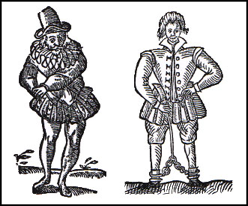
Anonymous SHAKE-SPEARE. The Man Behind
by Kurt Kreiler
Was the Earl of Oxford William SHAKE-SPEARE ?
It’s a matter of historic impossibility to attribute the Shakespearian body of work to the historic figure of Will Shakspere (1564-1616) from Stratford-upon-Avon. During his life time, nobody entertained the notion of William Shakspere's being an author. In other words: If we study documents that were written between 1594 and 1616, we do not find any documentary proof whatsoever (be it in the form of personal correspondence, a reference from a contemporary, a poem or even a receipt) that links the historical figure Will Shakspere to the author of the Shakespearian body of work. (One of Shakspere’s colleagues said that he had difficulty writing anything at all.) In 1623, seven years after the death of Will Shakspere, Ben Jonson wrote the introduction to Shakespeare's works, attracting the readers attention to “The sweet Swan of Avon” for the first time.
The author “WILLIAM SHAKESPEARE” had a firm understanding of Latin, Italian, French and Spanish, furthermore he had access to highly specialised literary sources. Such things were not taught in the Grammar School that William Shakspere went to. “Shakespeare” wrote 126 sonnets to Henry Wriothesley, Earl of Southampton, addressing him in the second person singular (thou) and criticising his morals. Should the actor Will Shakspere have perpetrated such an assault, he would have risked his profession.
Anonymous SHAKE-SPEARE. The Man Behind.
- Chapters 1 and 2 explain why Will Shakspere from Stratford-upon-Avon was not an author.
- In chapter 3, ten works of the author William Shakespeare will be analysed with a view to determine what criteria the author must have had in order to write the works in question. - Which foreign lands had the author visited? What historical references have been made? When were the pieces written?
- Chapter 4 examines the the social perspectives of the “Author of the plays”
- Chapter 5 examines what Shakespeare's literary contemporaries knew about him, with whom did they associate him, what qualities did they attribute to him?-An analysis of the Harvey-Nashe-Quarrel show us that they both agree that the author “Master William” was the creator of the figure Falstaff and that this author was Eduard de Vere, 17th Earl of Oxford (1550-1604).

-Chapter 6 deals with the first part of the biography of Eduard de Vere.
-Chapters 7 and 8 show that the the profile of the Author that was developed in chapters 3-5 correlates logically and universally with the biography of the Earl of Oxford.
-Chapter 9 is a continuation of the biography of the writer and spear shaker “William Shake-speare” up to his death in 1604.
-Chapter 10 shows why, how and for whom the dramatist Ben Jonson went about the task of procuring the nom de plume Shake-speare. By using the coincidental similarity between the names Shake-speare and Shakspere, Jonson posthumously set up a marionette to claim authorship of the Shakespearian works.
Preliminary:
Was the EARL OF OXFORD recognized and admired as an author by his contemporaries?
Yes he was.- William Webbe writes in “A Discourse on English Poetry” (1586):
“I may not omit the deserved commendations of many honourable and noble Lords and Gentlemen in Her Majesty's Court, which, in the rare devices of poetry, have been and yet are most skilful; among whom the right honourable Earl of Oxford may challenge to himself the title of most excellent among the rest.”
This was followed by George Puttenham in “The Art of English Poesie” (1589):
“And in her Maiesties time that now is, are sprong up an other crew of Courtly makers
Noble men and Gentlemen of her Maiesties own servants, who have written excellently well as it would appear if their doings could be found out and made public with the rest, of which number is first that noble Gentleman Edward Earl of Oxford.”
And Francis Meres named Oxford in his Palladis Tamia (1598) as one of “the best in comedy amongst us”.
Summary:
WILLIAM SHAKESPEARE had nothing to do with the actor and money lender William Shakspere from Stratford-upon-Avon. The man behind the nom de plum „William Shakespeare“ was, in fact, a very well educated aristoctrat who often frequented the court of Elizabeth and whose real name was Edward de Vere, Earl of Oxford. The dramas of the ‘spear-shaker’ were not primarily written for the public theatre but for the Queen's court. The dramatist Ben Jonson published Shakespeare’s works with a misleading commendatory poem.
These astonishing theories are not the theme of a fictional work. They are based on a diligently researched academic biography of the the author, albeit a biography that could have provided stories for some novels.
See the new Website: anonymous-shakespeare.com/